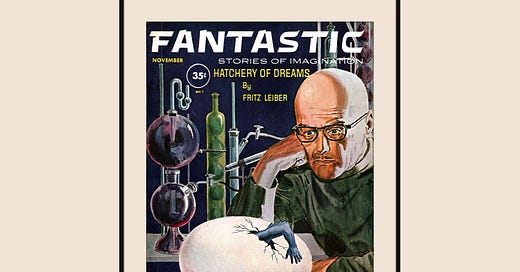Chasing the AI Mirage
We're standing on the precipice of a quantum leap in technology. What we do in this pivotal moment is crucial to our future and the future of the planet.

Hello, Friend,
I recently wrote about Jack Dorsey’s belief that all IP should be free of copyright restrictions so that AI can access every creative work ever produced in any medium for training purposes without the consent of or compensation to the creators. This article in the The Verge featured similar comments from former UK Deputy Prime Minister and former Meta executive Nick Clegg. Clegg insists that asking creatives for permission to use their content would ‘basically kill’ the AI industry. The logic he and other Tech Bros apply is fascinating, because it devalues creativity on one hand while admitting creativity has value on the other.
The co-opting of creativity seems to me to be the least interesting use of AI technology. It’s the low hanging fruit, the cheap parlor trick to hook people. As long as the Tech Bros can access all existing creativity for training for free, it is a no upfront cost way to build their large language and image diffusing models. It’s clear that AI has so much more to offer than generating derivative images, art, video, and text. It is capable of quickly analyzing massive amounts of data through pattern recognition. It has infinite potential for medicine in terms of diagnostics, treatments, research, medication development, and coordination of patient information. It could provide solutions to our most pressing problems like world hunger, climate change, immigration, homelessness, and pollution. It has integral implications in terms of science, technology, engineering, math, government, education, business management, and finances. It could streamline systems, solve problems, and free people to focus their energy on creative approaches to other facets of these things. (And also free people who currently lack the time to be creative.)
As a writer and artist, I will admit I’m biased, but it’s true that AI cannot create anything on its own. It is not (at least not yet) an autonomous, sentient being. It is an information aggregator. It copies art that humans have created from their human experiences and regurgitates it. As it is fed and collates content (writing, visual art, music, film, videos, etc.) it creates derivative works that degrade while being devolved into further derivative works. It isn’t offering anything to the equation beyond smashing things together into strange new shapes. Because it isn’t creating anything new, it collapses in on itself. In the process of processing information, AI begins to create hallucinations. It has a 60-79% error rate. This is a serious problem for all applications of AI even beyond art. AI companies do not yet know how to solve this conundrum.
It may not even be possible.
“There is still much we don’t know about the environmental impact of AI but some of the data we do have is concerning,” said Golestan (Sally) Radwan, the Chief Digital Officer of the United Nations Environment Programme (UNEP). “We need to make sure the net effect of AI on the planet is positive before we deploy the technology at scale.”
AI images are particularly problematic for various reasons, not the least of which is the amount of energy needed to produce them. It is the most energy consumptive of all AI applications. Much of this energy is produced from water with a large data center using about 550,000 gallons a day. This water evaporates, so it is not returned to the local watershed. We already have a water access problem globally, AI could exacerbate it exponentially. There is also the ecological impact of the waste products from the excessive use of energy production that results in extreme green house gas emissions and toxic electronic waste that includes mercury and lead. The images AI is creating may be fun for human generators or a problem solver for online companies or publishers with small budgets, but they are often more deceptive than useful, entertaining, or enlightening. This article from The Cool Down discusses the issue of online food images that make promises restaurants cannot deliver.
For writers, musicians, visual artists, film makers, video producers, and performers, AI poses a serious threat. By stealing content without compensation and creating derivative works that fail to cite or reward their sources, tech companies are making it increasingly difficult for creators to earn a living. Social media sites are being flooded with AI Slop, but as the technical quality improves, it will be challenging to separate reality from AI generated content. This will escalate as the technology evolves.
Beyond art theft, there are the considerable problems of deep fakes, cybersecurity threats, manipulation of algorithms and information, intrusive surveillance, job loss, propaganda, autonomous weapons, financial crises, and mass scale fraud. Wait until AI hits political campaigns! AI is only as good as the people programming it. What happens if or when it becomes sentient, if or when it evolves into artificial superintelligence?
Note that one of the nasty little nuggets tucked into Trump’s ‘Big Beautiful Bill’ is a 10 year moratorium on state regulation and oversight of AI. Our elected officials know it’s problematic, but they love that Tech Bro money too much to care. Greed supersedes caution when there’s enough profit to be made, and AI has monumental potential for developers and investors. Despite the dire warnings of many of the people who have been integral to its development, the Tech Bros are going full throttle into this Brave New World dragging the rest of us with them.
What AI portends for our future and the future of the planet is both exciting and troubling to ponder. This is the time to press our elected officials to rein it in before it gets away from us forever. We need to work towards international approaches to regulation. We need to protect the IP of creatives. We must hold tech companies responsible for the development of this technology and its implications. AI is not going away. How we utilize it and where it leads is entirely up to us. It would behoove us all to consider the deeper implications of that AI generated digital image or written work. The cheap parlor trick isn’t cheap, it’s a mirage designed to distract us from the true price we’re all paying to generate it.
Like it? Share it! Thank you!
Subscribe so you never miss another post! It’s free with the option for a low cost paid sub to support the work.
Can’t swing a paid sub? No worries! Consider buying your writer a cup of coffee!






Terrifying. But unsurprising that what will drive this is not anything even remotely helpful to humanity, but rather money and power.
This is beyond frightening! Excellent essay.Thank you!